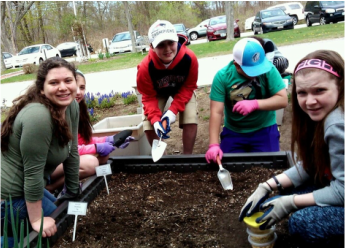 Even as I pour water on thirsty soil, and rain upon dry ground, so will I pour My spirit on your offspring, My blessing upon your posterity. And they shall sprout like grass, like willows by watercourses. Isaiah 44:3-4 We have ready access to water by simply turning a tap, but for the ancient Israelites much hard work was involved in securing sufficient water to sustain people and their animals. In Israel, rain falls only in the winter months, and largely in the northern part of the country. In the limestone hills, water collects underground in chambers and caves, and the ancient Israelites would dig down to find flowing water at underground springs or to reach below the local water table. Communities and individuals in the highlands hollowed out cisterns in the limestone rock to collect the winter rainfall running off slopes. Channels were cut to divert runoff into the cisterns, and cistern walls were plastered to minimize leakage and provide sufficient water for the dry months. At the southern end of the good agricultural land, wells were dug to access underground springs and find water, as Abraham did at Be’er Sheva. In the Biblical Garden this spring, students in grades 4 through 7 did winter clean-up, planted seeds in the raised beds, and scattered bedding plants around the garden. With much enthusiasm they potted up our two etrog seedlings, fragrant herbs, and the new dwarf pomegranate and olive trees, and carried pitchers of water from the convenient tap to water the results of their efforts. Indeed “water is life,” and a blessing no less precious in our day than it was to the ancient Israelites, who labored so hard to provide sustenance for their families. This summer, stop in and spend a few quiet moments in the Biblical Garden. There are fragrances, colors and sounds to be savored, and a bench awaits if you just want to sit. 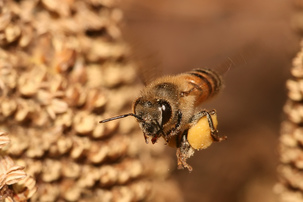 The fear of the Lord is clean, enduring forever; the ordinances of the Lord are true, they are righteous altogether; more to be desired are they than gold, yea, than much fine gold; sweeter also than honey and the honeycomb. Psalm 19:10-11 In the Bible, “honey” is generally assumed to be date honey, or silan, a boiled-down date and water mash. Beekeeping is not referred to in the Bible, nor, until recently, was there any evidence found of beehives at archaeological sites in ancient Israel. In 2005 at Tel Rehov in the Beth Shean Valley in northern Israel, archaeologist Amihai Mazar of the Hebrew University of Jerusalem, and his team made an extraordinary discovery: eight cylindrical beehives, which were confirmed by evidence of beeswax molecules in their unfired clay walls. In 2007, a large complex of additional hives were excavated on the site and dated to the mid-10th to early 9th century BCE. The beehives made of straw and unbaked clay, were found in orderly rows of 100, and are evidence of an advanced honey-producing beekeeping industry 3000 years ago. This apiary would have held more than one million bees, in the midst of what was a crowded city. As in other traditional beekeeping societies, people presumably learned to live alongside the bees, considering the precious commodity they produced. Mazar notes, ”This discovery has shed light on a hitherto unknown branch of the ancient economy, and we are fortunate that we can place the find within its context in the society, culture, and economy of ancient Israel.” As the warmth of the sun returns to the Biblical Garden, and the shoshanim -- narcissus, hyacinths, poppies -- prepare for their late spring display, a sleepy honeybee finds a warm spot of early morning sun and considers all of the busyness ahead in a new season of abundant budding and blossoming. She has fed all the cold winter on last year’s honey and when temperatures reach about 65 degrees she will begin again to collect nectar and pollen to feed her queen and raise a new generation. She is one of God’s small miracles, who live alongside us in the Biblical Garden. 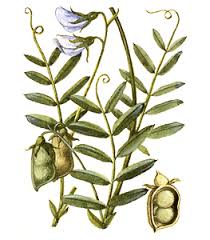 Once when Jacob was cooking some stew, Esau came in from the open country, famished. Esau told Jacob, "Let me gobble down some of this red stuff, since I'm starving." But Jacob said, "First sell me your birthright." Esau said, "Behold, I am about to die; so of what use then is the birthright to me?” Genesis 25: 29-31 Jacob’s brother Esau was a hunter, not for him the life of a tiller of soil, a farmer governed by the agricultural cycle. Esau was most at home in the wilderness, a wily tracker, steeped in the habits and habitats of wild creatures, skilled at stalking his prey and bringing game back to the family hearth. He would have ranged for miles in the hot desert scrub in pursuit of his quarry, and some days he came home with nothing, dusty, thirsty and famished. And on one of those days, there was that lazy twin brother, mother’s favorite, the gardener, taking his ease in the comfort of the camp while stirring a pot of lentil stew! Jacob had no trouble tricking Esau out of his birthright, because Esau’s stomach was in charge of his decisions on that day. Lentils, Lens ensculenta, are pulses, small members of the pea family that have been grown as a food crop in the Near East for at least 10,000 years, since Paleolithic times. Most familiar to many of us are the brown lentils we use in soups, but they can also be red, yellow and green, with different flavors and textures. Nutty-flavored, rich in protein, and nutritious, lentils are grown in the Biblical Garden, in a pot that is purposely taller than our rabbits can jump. The Religious School children particularly like to plant them because they are larger than most seeds, and they enjoy seeing them doubled in their dried pods in the fall, when they are collected and deposited in the seed bank for next season. Similarly we plant two other pulses in a raised bed: broad beans (aka fava beans), and, of course, chickpeas, all important staples of the Israelite diet. But back to the "birthright": the Google definition is twofold: · a particular right of possession or privilege one has from birth, especially as an eldest child or, · a natural or moral right, possessed by everyone. Our history, our faith and the values we learned from our parents is the birthright we give our children and grandchildren. At our best, we pass it on with intention, and we enlist family and community to help impart the extraordinary importance of the heritage that shapes so much of who our children are and will become. It is a solemn task and it is a privilege. It is our legacy, and some day it will be theirs as well. L’dor va dor. 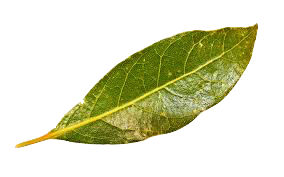 And by the river upon the bank thereof, on this side and on that side, shall grow every tree for food, whose leaf shall not wither, neither shall the fruit thereof fail; it shall bring forth new fruit every month … and the fruit thereof shall be for food, and the leaf thereof for healing. Ezekiel 47: 12 Plants played many roles in Biblical times, as they do today, for food, personal beauty, hygiene and ritual, and as aids to healing. Israeli botanical scholar Michael Zohary maintains that, “Although healing by plants in not explicitly mentioned in the Bible, herbal remedies were numerous and specific. The ultimate healer was God, and prayer was therefore the remedy most often prescribed.” Because mentioning medicinal uses of plants would defy the belief in God’s exclusive healing power, they were rarely mentioned in Scripture. And indigenous knowledge of medicinal properties of herbs and their uses in healing belonged to the women. In Talmudic literature, about 70 plants are mentioned as having medicinal properties, including olives, dates, pomegranates, quinces among fruit – garlic, beet, hyssop, cumin, and fennel-flower among vegetables and spices. In addition, wild plants are mentioned which were used principally for remedial purposes. One such plant is the sweet bay or bay laurel (Laurus nobilis), a tall, conical evergreen tree that abounds on Mt. Carmel and in the stony soils around the Galilee. The leaves of the bay, when broken, emit a sweet scent, and are used to flavor Mediterranean cuisine. In the ancient world, oil of bay was used externally in treating wounds and healing bruises and was also drunk in a tea for digestive ailments. The Biblical Garden grows a potted specimen of bay laurel, and it spends the winter indoors. If you want your own little evergreen supply for cooking, they are commonly available in any garden center in the spring, and can easily be maintained in a sunny window. The fresh leaves are very mild and do not develop their full flavor until several weeks after picking and drying. 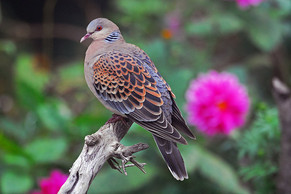 For, lo, the winter is past, the rain is over and gone; the flowers appear on the earth; the time of singing is come, and the voice of the turtle is heard in our land. Song of Songs 2:11-12 Tu BiShvat, the New Year for Trees, is a minor festival that occurs on the 15th day (tu equals number 15 in Hebrew) of Shevat, because, in Israel, most of the winter rains will have passed and the sap of the new growth has begun to flow as the dormant tree wakes from its winter sleep. Also known as Jewish Arbor Day or Tree-Planting Day, this year Tu BiShvat falls on February 3rd. It began as a tax day for calculating which fruit would be included in the tithe brought to the Temple. Following the destruction of the Second Temple, Jews in the Diaspora commemorated the festival by eating "first fruits" from the Land of Israel on Tu BiShvat, and by discussing Jewish values such as repair of the world, and alleviating the suffering of living creatures. Many communities celebrate a Tu BiShvat Seder, to give thanks for trees, harvests, and the natural world. It’s an opportunity to reflect on our responsibility to care for the environment, and on our sacred obligation to share the fruits of God’s earth with our neighbors. In Israel, Tu BiShvat has become a day for planting trees, and for pursuing environmental concerns such as the recurring water crisis in the land of Israel, and the problems of climate change, soil degradation and desertification, and loss of biodiversity. Kibbutz Lotan, a community in Israel's Negev conceived to fuse egalitarian ideology with Reform Jewish values, has become an internationally recognized institute for practical environmental education. The Center for Creative Ecology (CfCE) at Kibbutz Lotan is one of Israel's premiere environmental education, conservation and research institutes. Leah Zigmond, former Eco Center Academic and Educational Director at Kibbutz Lotan, writes: After God created the world, the Torah tells us there were no trees in the fields or herbs in the gardens, for God had not yet sent rain or created a human to work the soil. Only after forming man from dust and blowing life into his nostrils did God plant a garden. As it is written, "…God took the man and placed him in the Garden of Eden, to work and to protect…" (Genesis 2:5-2:15). …Note that God's act of planting the garden was unlike the creation of other natural spaces in that God simply commanded the latter spaces into existence. The garden, a metaphor for the earth, requires ongoing tending. Note, too, our original purpose as humans, according to the Torah: Our first job title was gardener. Caring for the earth is surely holy work, Jewish work.” While the young trees in the Biblical Garden may still be dormant in early February, hyacinth and narcissus bulbs have already sent up new shoots, and when the snow-cover recedes, we will be able to spot the tiny pink flowers of the early-blooming wild cyclamen under the crabapple tree. And in another sure promise of spring, our North American relative of the “turtle (dove),” the male mourning dove will soon begin giving his plaintive call in our back yards. 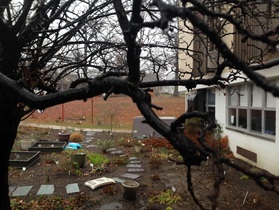 For to the snow God says, ‘Fall on the earth’, and to the downpour and the rain, ‘Be strong.’ Out of the south comes the storm, and out of the north the cold. From the breath of God ice is made, and the expanse of the waters is frozen. Job 37: 6, 9-10 Stubble of dried stalks, leafless shrubs and vines, calamus roots captive in a bucket of ice, unfamiliar shapes under contours of fresh snow – an overturned pot perhaps? The somewhat poetic translation of these verses from Job resonate – it’s winter in our New England, and in the Biblical Garden. The soil is frost-laden and unyielding; the garden is at rest, and the gardeners are watchful of the ever-so-slow increase of daylight, eagerly anticipating new beginnings and a fresh start. It’s a liminal space between the busyness of late autumn garden chores and the creative energy of spring, a quiet time to let go of the garden that was, and imagine the garden that could be. But beneath the insulating snow cover that protects plants from biting winter winds, all is not as quiet as it seems. The nutrients from compost added to the garden in fall bring moisture and nourishment to legions of soil bacteria and other microorganisms that will convert products of plant decay into nitrogen, essential for plant nutrition. While many soil bacteria go dormant in winter, millions of microbes continue to break down tough cellulose to make nutrients available to plants. Freeze and thaw cycles break up compacted clods and work small seeds down into the soil for germination. Earthworms burrow below frost level and hibernate. Under the hard crust of frozen earth, while the garden sleeps, the soil dreams of spring. For us too, winter is a waiting season of life, a time to pause and remember how blessed we are, an opportunity to be grateful for every moment. We may realize that the best moments could come now in these dark days, as we await the coming season’s growth, with its joys and its challenges, in our gardens and in our lives. 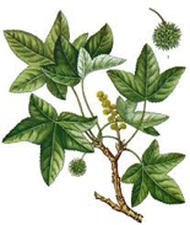 And the Lord said to Moses: Take sweet spices, stacte and onycha and galbanum, and pure frankincense with these sweet spices; there shall be equal amounts of each. You shall make of these an incense, a compound according to the art of the perfumer, salted, pure, and holy. Exodus 30:34-35 Stacte, or, in Hebrew, nataf, was an aromatic gum resin, one of the exotic and costly ingredients in the recipe for holy incense, which was burned in the Tabernacle, morning and evening, and was a component of the ritual performed by the High Priest when he entered the Holy of Holies on Yom Kippur. Compounding of the holy incense was a proprietary process and became a closely-guarded secret. Nataf was probably extracted from the storax tree, the Turkish sweet gum, which grows wild in Anatolia and possibly grew in Gilead, northeast of Israel, in biblical times. From its wounded bark was extracted an aromatic sap with healing properties, which was processed into a soft gum, preserving its aroma. Storax resin has a pleasant, sweet, balsamic, slightly spicy odor and its derivatives are used in fragrances and pharmaceuticals. It may indeed be the biblical balm associated with Gilead, although that identification is uncertain. The storax tree is deciduous, grows 6-10 meters tall, and produces a woody, prickly “gumball” of multiple seeds. A close relative is the American sweet gum, two mature specimens of which watch over the chapel-end of the Biblical Garden, and drop “gumballs” a-plenty in the fall. Rabbi Amy Scheinerman writes: "The hovering, lingering cloud of smoke produced by burning the incense was evocative of God’s presence, the pillar of cloud that led the Israelites through the Wilderness for 40 years.… Holiness is a double-edged sword: For something to be sacred, powerful, transformative, and inspiring, it must be protected from becoming mundane, common, the quotidian of life. But when we withhold that which is holy from others who might share in its value and power, we diminish the divine. The cloud created by the burning of the ketoret (the incense) combines these two seemingly contradictory values: the smoke rose up, and then spread out over the people – all the people." 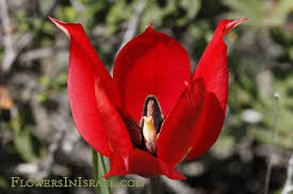 I am a rose of Sharon; a lily of the valley. Song of Songs 2:1 Solomon’s Beloved refers to herself as a rose of Sharon. The Sharon Plain lay along the Mediterranean Sea south of Mount Carmel, and was one of the largest and most fertile valleys in ancient Israel. The rose was not found in Israel in Biblical times, nor was the popular Rose of Sharon bush, the Hibiscus syriacus, which, despite its taxonomy, is a native of China. The rose of Sharon is a mistranslation of the Hebrew havatzelet which indicates an onion-like flower bulb. Dr. Ephraim HaReubeni, past professor of Biblical Botany at the Hebrew University, posited that the Rose of Sharon was a tulip, most likely the Tulipa agenensis subspecies sharonensis, also known as the Sharon tulip. The Tulipa agenensis is a wildflower that at one time grew abundantly across Israel. Now, because of development, the Sharon tulip is harder to find in the wild. Other scholars have proposed the Narcissus tazetta, which our Biblical Garden grows in abundance, as the flower Solomon had in mind. This fall the 5th, 6th and 7th grade students are putting the garden “to bed” for the winter, and planting a species tulip that resembles the commercially unavailable Sharon tulip, along with wild native hyacinth and saffron crocus. One of the joys of gardening with children, is sensing how connected they feel to the earth. They love to dig holes, plant bushes and bulbs and seeds and watch them grow. They smell the richness of the earth and discover life hidden under the soil. The Biblical Garden has now completed its fourth growing season, and the foundational trees, shrubs, grape arbor are established, thanks in large part to the eager labors of our young gardeners! And a special todah rabah to George and Judy Cohen, for yet another summer of ensuring the Biblical Garden has been regularly watered and for the other garden spots they tend at Temple Sinai, for the betterment of both people and place in our community. Thou shalt keep the feast of tabernacles seven days, after that thou hast gathered in from thy threshing-floor and from thy winepress.
Deuteronomy 16:13 Seven days shalt thou keep a feast unto the LORD thy God in the place which the LORD shall choose; because the LORD thy God shall bless thee in all thine increase, and in all the work of thy hands, and thou shalt be altogether joyful. Deuteronomy 16:15 In the Biblical Garden the growing season winds down once again: grapes ripened, cucumbers and cantaloupe exposed under drying leaves, dried pods of chickpeas, lentils and broad beans for our seed bank, a stem or two of sorghum cane laden with millet. The papyrus reeds that so delight the religious school children will soon die back with the cooler days, and poppies, feverfew, coriander and black cumin will continue to naturalize wherever their seeds fall. It’s been a good year, time for sweaters and the sukkah. In Exodus, Sukkot is called hag ha-asif, the festival of ingathering and the end of the year’s agricultural cycle. Barley was harvested in spring, and wheat in early summer, but the process of transforming the sheaves of grain into bread was an arduous one that took weeks of threshing, winnowing to separate grain from chaff, and sifting out impurities, before storing it in jars for milling, all to be completed before the first autumn rains. Then followed harvesting of grapes, figs, almonds, and pomegranates in mid-to-late summer and, lastly, olives in the fall. It wasn’t until grapes were pressed and processed into wine and olives into oil that the season of harvest and ingathering was truly over. Then came time for community rejoicing and the festival of Sukkot, a brief respite before the plow was again put to earth and the coming winter’s barley sown. In temporary shelters, families shared meals with guests, remembering the harshness of the wilderness years, and finding joy in the abundance now stored away to sustain the community in the coming year. Rabbi Paul Steinberg, in Celebrating the Jewish Year: The Fall Holidays writes: ”For us today, Sukkot’s most apparent complexity and richness lie in its disparity: we are drawn out of our own homes and ease of our modern lifestyle, yet simultaneously comforted by reconnecting with nature and our community. Sukkot culminates with the holiday of Simchat Torah, a celebration of all that God gave us. On this day we literally dance with the Torah scrolls to celebrate both the Torah itself and Sukkot’s messages about the essence of humanity, the beginnings of civilization, and the meaning of living in God’s world. It is the holiday that compels us to look upward, through the cracks of impermanence, toward the same night sky and stars upon which our earliest ancestors gazed. Here we stand, humbled, and filled with awe and gratitude for all there is, simply celebrating life.” Read more: "Why Sukkot is a Harvest Holiday, Even Though There's Little to Harvest" 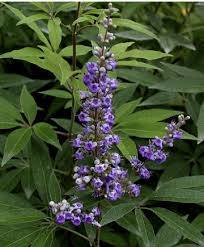 Neot Kedumim, the Biblical Landscape Reserve in Israel, is a unique recreation of the physical setting of the Bible in all its depth and detail allows visitors to see life as it was lived by our ancestors 3,000 years ago, and it is an invaluable resource for biblical gardeners everywhere. Dr. Sarah Oren, Curator of the Neot Kedumim Botanical Garden writes: "One of the most prominent late-summer plants is the Vitex agnus-castus, known by several names in English, including Abraham’s Balm and Chaste Tree. This member of the verbenaceae plant family grows by bodies of water all over Israel, except for the Negev desert. Genesis 22 relates the story of the Binding of Isaac, in which Abraham was commanded by God to sacrifice his son Isaac. In truth, he was not meant to kill his son; rather, he was being tested by the Lord to see to what extent his commitment and obedience would take him. When the angel stopped Abraham from harming Isaac, “Abraham looked and saw a ram caught in the thicket by his horns. Abraham went and took the ram, and offered him up as a sacrifice in place of his son.” (Genesis 22:13). One Jewish tradition teaches us that the bush in which the ram was caught was the Vitex agnus-castus. The Latin name reflects this tradition (vitex (= life) agnus (= lamb) castus (= humble), that is to say “the life of the innocent lamb” – Isaac. A third name in English also reflects this tradition, Abraham’s balm, and the Hebrew name of the plant translates to “Abraham’s bush.” The connection of this plant to this story is particularly appropriate now, as Rosh Hashanah is upon us. This is the time of year when the Abraham’s balm is in full bloom. Our Sages teach us that the Binding of Isaac took place on Rosh Hashanah, and Genesis 22 is read in synagogues around the world. The shofar (ram’s horn) that we blow on Rosh Hashanah is to, among other things, remind God of Abraham’s commitment to God's will, and to hopefully inspire God's mercy upon us during this period of divine judgment." Temple Sinai now has a Vitex agnus-castus in our garden collection, along with other new shrubs. The garden has yielded an abundance of herbs, pulses and cucumbers; and the grapevine on its new arbor is heavy with grapes. Now we welcome the New Year with hopes of reaping what the prophet Isaiah called the “good of the land,” and hope for a successful, happy and healthy year. |
AuthorsMichael Schlesinger is Temple Sinai’s Biblical Gardener. Mike has been gardening since he was eight years old. He used to grow grape vines and make wine when he lived in California. He now tends to our garden, continuing the traditions started by Catherine Walters. Archives
March 2020
|

Affiliated with the Union for Reform Judaism
30 Hagen Avenue • Cranston, RI 02920 • 401-942-8350 Office: dottie@templesinairi.org Rabbi Jeffrey Goldwasser: rabbi.j.goldwasser@gmail.com |
Want to sign up for the weekly Sinai Scroll email?
Click here to receive weekly updates on Temple services, events and a message from the Rabbi. |


